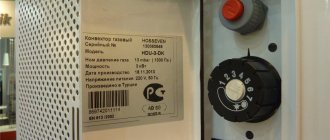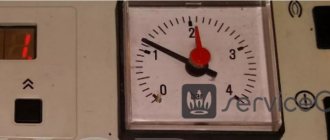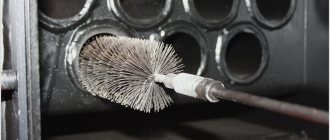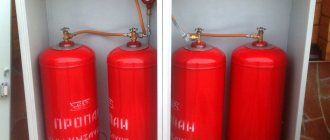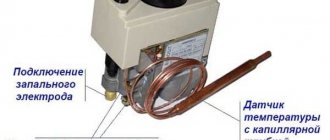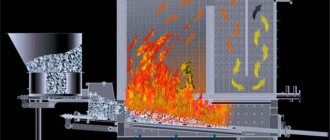A gas convector using bottled gas is used for autonomous heating of individual rooms due to convective heating of the air. Today it is rightly considered that this is one of the most energy-efficient methods of heating for a summer house, home, office and industrial premises, with an efficiency of about 90%. In non-gasified areas with a shortage of electricity, such devices are the only sources of heat. Despite the fact that this heating system requires the presence of group cylinder installations, the cost of generating a unit of thermal energy of 1 Gcal is much less than that of electric heating and boiler equipment.
Device and principle of operation
A convector heats a room by circulating air through an internal heat exchanger using natural or forced convection.
In general, the heating device works as follows:
- Liquefied fuel comes from a gas cylinder unit to a burner device, where it burns, forming hot flue gases.
- Flue gases, under the influence of natural or forced circulation, wash the outer surface of the heat exchanger, thereby heating it to high temperatures.
- Cold air entering it from below is heated through a developed heating surface and is released into the room naturally or forcefully with a fan.
- The exhaust gas manifold retains combustion products in the heat exchanger for maximum cooling and then discharges them through a chimney or coaxial pipe into the atmosphere. When using such a pipe, hot air flows through the inner ring to ensure complete combustion of gas in the convector, and it is taken from the atmosphere.
To ensure the combustion process and transfer of thermal energy to the heated room, the convector is made of the following structural elements:
- The gas burner organizes the process of complete combustion of gases and transfer of thermal energy to the heat exchanger.
- The heat exchanger organizes heat transfer from flue gases to air masses indoors.
- The control module performs temperature control and gas supply volume regulation.
- A chimney or coaxial pipe removes combustion products to the external environment.
- The fan carries out forced air circulation.
- The gas cylinder installation is used for storing and transporting liquefied gas to the burner device.
Gas convectors running on bottled gas
Advantages and disadvantages
Liquefied gas is a flexible and versatile fuel source, an ideal choice for those living in gas-free areas. In terms of its characteristics, ease of control and instant heating, it is no different from natural gas.
Advantages of gas convectors using bottled gas:
- "Clean" fuel. When comparing LPG directly to other fossil fuels, oil and coal, it is a much cleaner use case. When burned, less sulfur, nitrogen oxides, carbon dioxide and soot are produced. Even if the fuel is “spilled”, it will not pollute the ground or water.
- Convenience. Conventional gas tanks can be used.
- The heat transfer process is easily controlled, like main gas.
- The heat generation process occurs quietly and without gas pollution. Compared to the use of liquid fuel combustion, the devices are smaller in size, have low heat production costs and do not require special maintenance.
- Excellent efficiency. One of the key reasons for the popularity of using liquefied gas is this indicator. Modern gas convectors are very efficient. This is achieved through more complete use of hot flue gases in a heat exchanger with a developed heating surface and the use of control and protection systems.
There are no ideal heat supply systems in the world; the use of liquefied gas for heating in convectors also has disadvantages that must be taken into account when organizing this type of heating:
- Delivery. For stable operation of the heating system, you will need to have reliable and inexpensive sources of liquefied gas supply.
- The storage tank should provide a 10-day supply of gas.
- The need for annual maintenance of the gas cylinder installation by gas service specialists.
- The high price of liquefied gas, which in some areas approaches the cost of electricity.
Gas convector Alpine Air NGS-20F
Gas heaters for outdoor use
A gas heater is a device that, in addition to heat waves directed at a specific item or object, also emits light. The long-wave device heats everything that comes within its range. It does not waste thermal energy to heat the air mass, which creates reasonable preconditions for its use in the open air.
An undeniable advantage of gas heaters is their autonomy. It is mobile and does not require connection to centralized power networks. Can be used for forcing seedlings in the cool season, to maintain a comfortable temperature in winter glazed gardens.
Image gallery
Photo from
Gas heaters are effective in open areas
Advantages of devices in the dark
Stationary heater in the form of a fireplace
Mobile gas equipment is a priority
Depending on the power of the gas burner, the radius of the comfortable zone can be from 2 to 5 meters. The variety of models and exquisite shapes of gas outdoor heaters will add zest to the appearance of your dacha. And the gentle warmth and fresh air will not leave anyone indifferent.
When choosing an outdoor gas heater, you need to pay attention to price and fuel consumption
Operating principle of an outdoor heater
The design of an outdoor heater consists of a base, a gas line and a burner. To give good stability, the base is made quite massive, and a gas cylinder is mounted in it. The gas then rises through gas pipes hidden in the heater rack.
At the very top there is a gas burner with a reflector. When gas burns, infrared radiation is produced, which heats objects, but not the air. A gas outdoor heater in the comfort zone increases the temperature by 10 degrees.
The cap is made of a material that reflects heat and light well. Therefore, the cozy place is not only warmed, but also illuminated. Before the invention of the light bulb, cities were lit by gas.
The burner is ignited, as a rule, due to the built-in piezoelectric element. The vast majority of models have power adjustment. The devices are completely autonomous and do not need to be connected to the mains.
Most models are more than two meters high. When installing, the distances recommended by the manufacturer from the walls and ceiling must be observed.
Characteristic advantages and disadvantages
The advantages and disadvantages of an outdoor heater are determined by its design features and heating method. Among the advantages:
- excellent design;
- simple design;
- electronic independence;
- mobility.
A gas heater is the most economical and practical compared to heaters using other types of fuel. In addition, the combustion of gas produces almost no harmful substances or odors.
However, due to the specific nature of the application, outdoor heaters are forced to be produced with somewhat excess power. According to the manufacturers, 92% of the energy they generate is directed directly to heating objects in the field of operation of the device, and 8% is spent on air.
There are several disadvantages:
- not the highest efficiency;
- relatively high gas consumption;
- high price, justified by the use of materials resistant to atmospheric negativity.
It is recommended to use outdoor heaters at ambient temperatures of +5..+10 degrees. They are not suitable for indoor use.
Safe operation of gas equipment
Before you start using a gas appliance, read a few simple rules:
- Before turning on the gas equipment, check the condition of the rubber hoses.
- Observe the recommended distances from the ceiling and walls.
- Do not store gas cylinders in the house.
- Do not operate gas appliances near open flames.
- If lighting with a match, light the match first and then turn on the gas supply.
- If you are leaving, turn off the gas cylinder valves.
- Before use, carefully read the instructions for the device.
The outdoor gas heater is designed for mass buyers and does not require special maintenance.
Depending on the design, the gas cylinder required for operation can be located at the bottom of the device or in a utility box separated from the home. Compliance with simple rules guarantees long and reliable operation of simple equipment.
Please note: the gas cylinder must undergo periodic verification.
Criteria for choosing an outdoor heater
In order not to get lost in the variety of models, there are several tips for choosing:
- To heat a space of 25-30 m², a power of 12 kW is required. Based on this, the power of the device is calculated.
- It is desirable to have a smooth change in power, and not just a minimum and maximum.
- Availability of automatic emergency shutdown, for example, in case of a fall.
- The case material is preferably stainless steel.
- Ensuring the ability to operate on liquefied gas and natural gas.
When choosing a gas heating device, you need to pay attention to the diameter of the reflector in order to determine the coverage area of the device. It would be nice if the heater had economical gas consumption.
If you need to heat a large area, it is better to buy two heaters. This way you will achieve a more even heat distribution. With one but powerful heater installed in the center of the heated area, the temperature may be uncomfortably high.
Features of operation and selection criteria
The system for the transportation and use of liquefied gas is classified as a hazardous facility, therefore it is subject to state technical rules for installation and operation. Installation and adjustment work must be carried out by specialists, despite the fact that it is technologically possible to independently wire such a convector.
The convector equipment market has a wide range of devices with different operating parameters. When choosing a gas convector, buyers should first of all pay attention to the availability of a kit for operating on liquefied gas, as well as the type of installation: floor and wall. The former have large dimensions and weight and are not always suitable for the heating object. Wall-mounted units are compact and fit well into almost any room, but have power limitations of up to 10 kW.
To organize effective heat exchange in large rooms, it is recommended to choose installations with forced air circulation using a fan.
Combustion chamber type
There are two types of combustion chamber: closed and open. Based on the requirements of sanitary and environmental protection, today a closed fuel combustion scheme is more preferable. The difference between them lies in the design of the flues. In the first case, instead of a stationary chimney located in the space between the walls, a coaxial pipe is installed. Structurally, it is made of the “pipe-in-pipe” type and allows not only to exhaust flue gases into the atmosphere through a central pipe, but also to transport the air necessary for combustion through the inner ring to the convector. The air passing along the hot chimney heats up, thereby generally increasing the efficiency of the installation.
Despite the fact that such a chimney exhaust system significantly increases the cost of installation, however, recently it has been used most often, since in this case the risk of carbon monoxide poisoning is reduced. The use of open systems is advisable in cases where they are installed in place of former wood-burning fireplaces or stoves using existing chimneys. In this case, you should not be afraid of contamination of the room with flue gases, since they will be no more than from a gas stove during cooking.
Gas convector DEMRAD PROMETHEUS NGS2 – 40
Power and gas consumption
Calculation of power and gas consumption depends on many parameters and factors related to both the characteristics of the device and environmental conditions.
There is a special formula that allows you to calculate the average power of a gas convector. It looks like this:
P = k S , where:
- P - power;
- k is a coefficient that takes into account the type of system and operating conditions, it is also called a correction factor;
- S is the area of the room.
The value of k for the central part of Russia is taken equal to – 0.1. If the only source of heat in the room is a gas convector, then this value is 0.12. At control points and rarely visited rooms, the coefficient is 0.15.
Then the consumption of liquefied gas is calculated according to the ratio: per 1 kW of output power when the convector is operating, there is 0.09 kg of liquefied gas.
Heat exchanger material
The material from which the heat exchanger is made is important because the service life of the convector depends on it. Mainly steel and cast iron heat exchangers are used, the former are much cheaper and lighter in weight. Cast iron devices have high corrosion resistance and ensure continuous operation of the convector for up to 50 years. In addition, due to their inertia, after turning off the gas, they remain hot for a long time and continue the heating process in the room.
Steel convectors are sold in a wide range of thermal power from 5 to 12 kW or more, while cast iron gas heaters are produced no higher than 5 kW. The steel structure allows you to diversify the design of the installation, for example, placing heat-resistant glass on the panel so that the user can admire the mesmerizing flames.
Control automation
According to the requirements of Russian standards, in particular, GOST R 51377–99, the use of gas convectors with or without a thermostat is assumed. The latest models of the device are almost all produced with thermostats since it ensures heating comfort and reduces gas consumption, while guaranteeing reliable and long-term operation of the heater.
The convector operation protection system is provided by a thermostatic gas valve, for example, Italian-made Sit Eurosit 630.
Gas valve functions:
- Adjusting the gas pressure on the burner;
- gas supply to the igniter and ignition;
- automatic regulation of internal air temperature with a response level of 1C;
- shutting off the gas in an emergency in the event of flame separation and a violation of draft in the chimney.
Violation of draft in gas ducts is controlled using a pressure switch, which sends a signal to the gas shut-off valve. Flame control is realized using a thermocouple. In energy-dependent devices, modern ionization flame control is installed.
In addition, in the struggle for their customers, many manufacturers began to install electromechanical timers on convectors to turn devices on/off for 24 hours and air humidifiers in the form of an open vessel into which water must be regularly added.
Gas convector AKOG-2
Equipment installation
Installing the convector itself is not difficult; special requirements are placed on gas equipment, the installation and commissioning of which must be carried out by gas specialists. The heating process from bottled gas will also require the presence of a gas bottle installation, which should provide at least a 10-day supply of fuel. For large objects, gas tanks are installed.
Main stages of work, their features and requirements of SNiP standards:
- System design. During this stage, the thermal power of the installation, equipment and many other parameters are determined.
- Supply of equipment. Today there are no problems with the delivery of selected equipment; it can be organized via the Internet, directly to the buyer’s home.
- Installation and commissioning works with the execution of contracts with a specialized organization that will be responsible for the quality of work and safe operation of the installed equipment.
- Refilling the system with liquefied gas.
- Equipment service.
Basic requirements for installing a liquefied gas heating system:
- It is not recommended to store cylinders with liquefied gas outdoors; in the cold season, the heater may stop due to a decrease in gas pressure; it is recommended to place them in rooms adjacent to residential buildings.
- It is forbidden to place cylinders in basements or in rooms with a pit, since propane is heavier than air and, if it leaks, it can collect below, leading to an explosion.
- The gas tank must be equipped with a system of mechanical safety valves to relieve excess gas pressure into the atmosphere.
- The gas system must have a special reducer that regulates the pressure in the gas pipeline to the gas burner.
- During operation of convectors, it is necessary to follow the manufacturer's instructions, and in the event of a gas leak, close the valve.
How long does the inverter work?
The inverter does not have internal batteries, but instead uses external ones. Thanks to this, it becomes possible to select a volume of batteries that will ensure the required period of independent operation of the uninterruptible power supply device.
Let's talk in more detail about the time of independent operation of the system. To calculate charge time, you need to divide the volume of the battery by the current it produces (in amps).
To determine the battery current (IAB), we rely on the law of conservation of energy, in which case the efficiency of the inverter will be one hundred percent. The required result is that the multiplied volts and amperes of the Inverter Battery equals the multiplied volts and amperes at the output.
Calculation of battery voltage = 12 V (in stronger models there are 24 V and 48 V), let's call it UAB. Volt*amps output is the power connected to the load inverter Pload.
We recommend: A stove being used in a garage: pros and cons, drawings, how to make it yourself, video
As a result, we have the calculation Pload = U battery * I battery, as well as I battery = P load / U battery.
If we know the volume of the battery of the battery, then we can find out how long it will work autonomously: tАВТ = SAKB/(Pload/UAKB) = SAKB*UAKB/Pload.
So, let's say we have an inverter connected to a 55 Amp*Hr battery with a 300 W load. Let's calculate how long it will work independently.
- UAKB = 12 V
- Pload = 300 W
- SACB = 55 Amp*hours
We make the calculation: tАВТ = SAKB*UAB/Pload = 55*12/300 = 2.2 hours.
And another question is what kind of battery is needed to ensure a certain operating time: SAKB = Pload*tAVT/UAB.
Twelve battery pack
For example, let's calculate what kind of battery we need for a given inverter in order to provide 2.2 hours of independent operation with a load of 300 W: SACB = 00*2.2/12 = 55 Ampere*hours.
